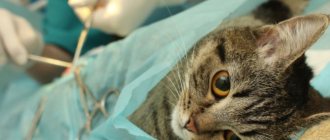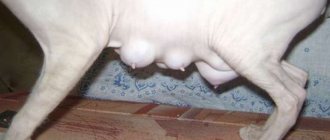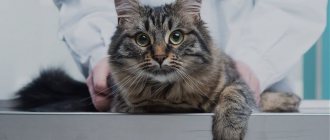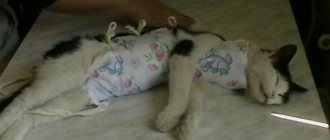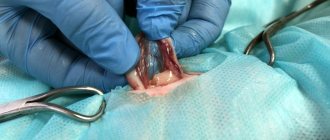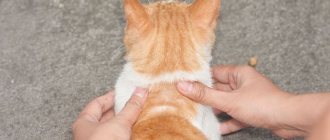9025Administration
Sterilizing a cat is an operation during which the animal's ovaries are removed, most often along with the uterus. This operation can be performed either in a clinic or at home.
How long does it take to sterilize a cat? It depends on the place where it is carried out, most often it does not take more than two hours.
Neutering cats is becoming increasingly popular. Many people are bothered by the wild screams of cats every spring; someone is afraid that their pet will become infected with a sexually transmitted disease. Also, the popularity of the operations is due to the overabundance of kittens given “in good hands” and street cats.
The most popular reason for sterilization is spring cries. This only happens because a cat, ready to mate, invites the cats on a “date.”
Hormones, special pills and, in fact, sterilization will help prevent this process. It is good if you do the operation before the first heat.
After the operation, the pet is “rehabilitated” for about a month and becomes calm and sweet. She temporarily stops producing female sex hormones, which reduces hormonal levels and stops the desire for sexual desire. With a decrease in hormone levels, the animal becomes cute not for a certain time . The animal may lose excessive aggression and improve its character.
© shutterstock
What is sterilization, types
Sterilization, as a rule, is an operation in which partial (oophorectomy) or complete removal of the reproductive organs (ovariohysterectomy) is performed in females or males. Sterilized animals lose their ability to reproduce and their sexual instincts.
The term sterilization also sometimes refers to the ligation of the spermatic cords in cats (vasectomy) and the fallopian tubes in cats (tubal occlusion). In animals, sexual behavior is completely preserved, but the ability to reproduce is lost.
In modern veterinary medicine, the most common types of sterilization of cats are oophorectomy and ovariohysterectomy. In the first case, only the gonads are removed, in the second - the ovaries and uterus.
For young females who have not been in heat or pregnancy, ovariectomy is sometimes performed. Ovariohysterectomy is recommended for adult cats. Removing all genital organs will eliminate the risk of future uterine cancers.
Vasectomy and tubal occlusion are considered outdated methods and are practically not in demand.
Sterilization before the first heat: laparoscopic and standard
The main purpose of sterilization is to eliminate the pet's ability to reproduce. There are several types of operations:
- Ovariectomy is the surgical removal of the ovaries. The operation leads to the cessation of hormone production and the impossibility of fertilizing the cat. This method is recommended for young pets with no history of childbirth.
- Ovariohysterectomy - removal of the uterus and its appendages. The operation can be performed on adult cats. This type of sterilization is also indicated for animals with various pathologies of the uterus and ovaries.
- Tubal ligation is a manipulation that prevents the possibility of fertilization without a hormonal shift; this operation is associated with a high risk of complications.
- Hysterectomy is the surgical removal of the uterus.
True, not everything is so simple. They resort to this only if there are truly objective veterinary indications:
- The cat has serious gynecological pathologies, including neoplasms in the uterine cavity or genital tract. For example, even in young animals there are rare cases of pyometra, when during the first estrus a copious discharge of purulent exudate begins from the external genitalia. At the same time, you should not wait until the end of the hunt, as the animal may develop sepsis.
- Extremely inappropriate behavior of an animal during sexual hunting. In these cases, it is better to suppress it with sedatives, and carry out the operation after the end of the heat. It will be much safer for the cat herself.
Some owners believe that cats should be sterilized during their first heat cycle: there is an opinion that the animal’s body “ripens” at this time. It is nonsense.
Moreover, practicing veterinarians always advise sterilizing cats before the first heat, since in this case it is possible to reduce the likelihood of developing gynecological pathologies.
If the owners have lost time and their pet has developed her first heat, it is better to be patient and wait until it ends (and only then carry out the operation).
The operation is practically no different from that performed under normal conditions, but still in this case it has a few specific features:
- During the procedure, the specialist pays more attention to the quality and methods of applying the ligature (due to increased blood supply to the genital organs, the risk of bleeding is higher).
- Before sterilization, it is necessary to conduct a biochemical analysis of the animal's blood. This is done to determine the level of sex hormones. If it is too high, it is better to postpone the operation for several days.
- In some cases, hormone replacement therapy may be required. They resort to it to reduce the load on the body of the operated animal.
Technique
It is no different from other abdominal operations. It is done only under general anesthesia, after high-quality premedication (this is what is called preparation for general anesthesia).
Today, veterinarians prefer to immediately remove the ovaries and the uterus itself during standard cavity sterilization.
Since conventional sterilization involves a “full” laparotomy (i.e. opening the abdominal cavity), the rehabilitation of the animal in this case is quite difficult:
- The pet must wear a compression bandage for at least one week from the date of surgery. Active cats are additionally fitted with a surgical collar to prevent licking and scratching of the sutures.
- For the first week after sterilization, it is advisable to feed your pet only liquid or canned food, which puts minimal stress on the organs of the digestive system.
- For at least two weeks from the moment of sterilization, you need to limit the animal’s physical activity, do not play with it, and do not allow small children near the cat. This is due to the relatively large surface of the suture surface. Under strong mechanical stress, the seams may well come apart.
- The seams themselves need to be looked after by wiping them with a solution of miramistin or chlorhexidine about once a day.
We invite you to read: Why tri-colored cats bring happiness
Not too new, but still a progressive method of de-fertilizing animals. Currently, they are resorting to it more and more often.
Technique
The essence of the technique is that the operation is performed through a small incision in the abdominal wall. To perform sterilization, a flexible probe with a camera is used. The pain reaction in this case is minimal, and therefore in some cases it is possible to do without general anesthesia (but this is still not recommended).
This method is ideal for depriving animals in heat. Please note that laparoscopic sterilization cannot be used during pregnancy. In addition, with this technique, infertility can be performed only in two ways:
- The ovaries are removed.
- Fallopian tube ligation is performed.
For surgical excision of both the ovaries and the uterus itself, conventional sterilization should be used.
Alternative to sterilization in cats
A good alternative to sterilizing cats is to temporarily lose the animal's ability to reproduce with the help of medications.
A special implant is inserted under the skin, which ensures the cat’s sterility for six months. Chemical sterilization is justified when the animal has contraindications to surgery to remove the genitals. Medical sterilization is used only for males.
For females, hormonal contraceptives are used, which reduce sexual desire, but do not ensure sterility of the genital organs. Regular use of such products leads to hormonal imbalance and health problems in pets in the future.
Maybe we should not?
Can a cat be spayed while in heat? We will definitely find out the answer to this question, only a little later. For now, let’s talk about whether it’s worth interfering in a cat’s life at all.
Why don’t owners deprive their pet of reproductive internal organs? Common reasons:
- You need it once for your health.
- I want kittens.
- The cat should feel like a mother.
- This is dangerous for her health.
- It's against nature.
- Not humane, period.
Now we will consider these points in detail. It’s necessary for health, then? Cats do not derive any pleasure from sexual intercourse, unlike humans. On the contrary, females experience pain. The pain of conceiving kittens, then 60 days of restructuring the body, then painful childbirth and feeding the cubs. When the kittens are a month old, the mother cat looks exhausted and very thin. What's the health like there?
I want kittens. To whom? To the cat? Hardly. Rather, the owners. One can understand the owners of expensive purebred animals with excellent pedigree and top marks at exhibitions. Such kittens cost a lot of money, and it’s clear why a cat is bred.
But if Murka the noblewoman gives birth to children, where will they go next? Give it to friends? Alas, most often no one needs outbred kittens. Throw it out onto the street? Destroy? Keep the entire litter for yourself? Not the best options.
The cat should feel like a mother. Did she say that herself? Or did the owner decide? The cat doesn't owe anything.
This is dangerous for her health. Much more dangerous are drugs such as “sex barrier”, which destroy the liver. Or a hormonal imbalance in the animal’s body.
We suggest you read: Ducklings raised at home
It's against nature. The firmest belief, for some reason. People do many things in their lives against nature. And sterilizing a cat is not the worst among them.
This is inhumane. Is it more humane to drown kittens or euthanize them? Sterilization is the most humane method for preventing the birth of unwanted kittens.
Sterilization of cats: methods with photos
Surgical methods of sterilization are classified according to access to the abdominal cavity:
- incision along the white line of the abdomen (median laparotomy);
- lateral access;
- laparoscopic method.
Access along the linea alba is one of the most common methods. It allows you to objectively assess the condition of the internal organs and is considered less traumatic. The method is used both for oophorectomy and ovariohysterectomy.
A lateral incision is used when sterilizing stray cats and aggressive animals, when postoperative care should be kept to a minimum. The advantage of this method is that the seam is small and there is no need to wear a blanket. Disadvantage: increased risk of postoperative complications.
The laparoscopic method is essentially seamless sterilization. Advantages: minimal tissue trauma, good visualization during surgery, and no need for sutures for punctures up to 3 mm. With laparoscopic castration, the risks of infection entering the cavity are reduced.
When is the best time to sterilize?
Puberty occurs in cats by 5 months. It is believed that from this age the animal can be sterilized. However, experienced veterinarians do not advise rushing into surgery. Young individuals tolerate anesthesia less well, grow and develop more slowly if the procedure was performed before 7 months of age.
The best period for sterilization is considered to be from 7 months to 10 years. Older animals have a risk of serious complications in the form of exacerbation of chronic pathologies.
Changes in physiology and behavior
The first heat or estrus begins in cats after the completion of puberty at 6–10 months, in large breeds later. From this moment on, it repeats regularly, accompanied by hormonal surges and behavioral changes.
The sexual cycle consists of the following stages:
- The preparatory period , proestrus , lasts 2–3 days. Under the influence of the gonadotropic hormone of the pituitary gland, the growth of ovarian follicles begins, and the secretion of estrogen increases. The uterus swells, its walls thicken, and a liquid transparent secretion is released. The reproductive system prepares for mating and ovulation. The pet becomes excited, fawns over its owners, meows, scratches surrounding objects, but does not let the cat near.
- The second stage , estrus , lasts 6–7 days. The concentration of estrogen increases, the uterus prepares to accept and store the embryo. The female makes guttural sounds, inviting a partner, crouches to the floor, raises her tail, and walks on bent legs. She runs to the litter box more often, marks her territory, hardly eats, and drinks a lot. The vulva enlarges, clear mucus without blood is secreted, which the animal licks. During mating, the secretion of luteinizing hormone increases, which stimulates the rupture of follicles. After ovulation, the amount of estrogen decreases sharply. The ovaries form the corpus luteum, which secretes progesterone. Under its influence, the endometrium thickens, and the uterus awaits the embryo. Fertilization occurs 1–2 days after mating.
- The third stage , metestrus , lasts 8 days. After ovulation, the sexual instinct dies out, the female ceases to be interested in cats, and behavior returns to normal. If fertilization does not occur, the concentration of progesterone drops, and physiological changes are repeated in the reverse order. Sometimes an animal begins to have a false pregnancy. If the female does not meet a partner and mating does not occur, the cycle repeats after 3 weeks.
At the end, the resting phase begins - anestrus; this happens more often in the winter season, when daylight hours are reduced, lasting from 3 weeks to 3 months. Hormonal levels are stabilizing.
How to sterilize cats
The surgical technique depends on the method of sterilization. Brief description of each method:
- Access along the white line of the abdomen. Before surgery, the cat's hair is shaved from the navel to the last pair of nipples. The length of the incision varies from 1.5 to 5 cm and depends on the size of the pet, the qualifications of the veterinarian, and the presence or absence of certain pathologies in the patient. The operation takes about 20 minutes. In complex cases, the procedure may take the surgeon 40-60 minutes. After the operation, it is necessary to wear a blanket to prevent the stitches from licking and causing infection.
- Lateral access. An incision is made from the side, in the iliac region. After removal of the genitals, intradermal absorbable sutures are applied that do not require removal. The operation takes 30-40 minutes.
- Laparoscopic method. Refers to the most gentle types of sterilization. Through a small incision made on the lateral line of the abdominal wall, a laparoscope and a manipulator are inserted into the cavity. The surgical space is achieved by filling the peritoneum with carbon dioxide. During the operation, the surgeon monitors the condition of the internal organs through a monitor. Laparoscopic sterilization lasts 15 minutes.
Regardless of the method of surgical sterilization, cats are prescribed general anesthesia. To determine the exact dosage of the drug, the animal is pre-weighed.
What are the consequences of sterilization during such a period?
A sterilized cat becomes less aggressive, stops marking and tearing up furniture, is more cooperative and amenable to training. The pet's appetite increases, so it is important to introduce specialized premium food for sterilized cats into the diet to prevent excess weight gain. It is important to be attentive to your cat and ensure it has a balanced diet.
how to tell if a cat is pregnant
If the owner does not plan to breed kittens, and during estrus the cat causes certain inconvenience for all family members, veterinarians recommend sterilization. With this procedure, the reproductive organs are surgically removed, after which the cat permanently loses its reproductive functions.
What are the wrong decisions made by many cat owners who do not want to sterilize:
- keep the cat at home during heat, preventing her from finding a potential mating partner;
- They feed the cat birth control pills, which reduce the likelihood of fertilization.
Each option negatively affects the mental and physical health of your pet. The best way to protect a cat from an unwanted pregnancy is a radical intervention that allows you to solve the issue of offspring once and for all!
By coincidence, many cat owners remember the need for sterilization only during the period of estrus, which is the main sign of puberty and readiness for childbearing. Is it possible to sterilize a domestic cat during heat or is it better to postpone this procedure for a certain period of time?
According to experienced veterinarians, it is undesirable to carry out radical intervention during estrus, which is justified by a number of reasons:
- the intervention process becomes more difficult, which is associated with a rush of blood into the pelvic organs;
- during estrus, a change in hormonal levels occurs, which can negatively affect the condition of the animal after the procedure;
- psychological factor;
- There are risks of postoperative complications.
The postoperative period during standard abdominal surgery depends on the individual characteristics of the animal, as well as the course of the surgical procedure. Typically, recovery takes about one week. During rehabilitation, it is necessary to wear a special bandage, as well as a collar; such measures prevent injury to the stitches and licking of wounds.
Wound treatment is carried out using special antiseptic solutions. Chlorhexidine or Miramistin are most often prescribed. Treatment of sutures helps prevent the addition of a secondary bacterial infection.
It is recommended to carefully monitor the animal for a week or a week and a half to prevent jumping from great heights or injury as a result of a fight with another pet. It is also recommended to limit your pet’s contact with small children.
Diet therapy involves reducing the load on the digestive tract. Constipation should not be allowed to occur, as an increase in intra-abdominal pressure can lead to suture divergence. Therefore, it is recommended to enrich your cat’s diet with soft food and sufficient water.
How to prepare an animal for the procedure
Cat sterilization is carried out only after preparatory measures, which include:
- deworming and vaccination of the animal;
- blood and urine tests;
- ultrasound examination of the genital organs;
- ECHO of the heart.
Deworming and vaccination increase the animal's immunity and reduce the risk of complications in the postoperative period.
The cat is given anthelmintic drugs 2 weeks before the proposed surgery, vaccinations are given at least a month before surgery.
If there are fleas, it is also necessary to do antiparasitic treatment 7-10 days before the procedure.
Before sterilization, the female is prescribed a starvation diet for 8-12 hours. Access to water is limited 3 hours before surgery.
How much does it cost to sterilize a cat?
The price of the operation depends on the method of the procedure, the region, whether a cosmetic suture was applied during the surgical procedure or a regular one. The cost of sterilizing a cat is also affected by where the operation will be performed: in a clinic or at home.
Abdominal surgery, which involves an incision along the white line, costs on average 3000-3500 rubles. Performing a cosmetic seam costs 500-600 rubles more.
The cost of laparoscopic sterilization starts from 5,000 rubles.
How to care for a cat after sterilization
After sterilization, the cat is under the influence of anesthesia for 5-10 hours. During this period, the animal may behave inappropriately. Under the influence of anesthetic drugs in the first hours after surgery, the coordination of movements in females is impaired. Therefore, it is very important to monitor the cat at this moment so that it does not get injured when walking or jumping on furniture.
When castrating by the cavity method, a blanket must be put on the animal immediately after the operation. The protective bandage against suture licking is removed after 8-10 days.
The cat's bed should be placed on the floor and away from objects that the cat might hit while off medication.
On the first day after castration, the pet is placed on an absorbent bedding, since under the influence of anesthesia the animal cannot control the process of urination.
As prescribed by the veterinarian, the sutures are treated with local antiseptic agents. For these purposes, use a solution of Chlorhexidine, Dioxidine, and Tetracilin powder. For faster healing of sutures, Ranosan ointment can also be prescribed.
After surgery, antibacterial therapy is required in the form of injections of Sinulox, Amoxicillin, etc. The patient is given an antibiotic immediately after surgery. It is recommended to re-inject after 48 hours.
You should not feed your cat in the first 6-8 hours after sterilization. During this period, there is a high risk of gag reflex.
During the first day after sterilization, the pet is fed only liquid or semi-liquid food (broths, baby meat purees). If a cat refuses to eat, you should not force feed it. If you have no appetite for more than a day after surgery, this is a reason to consult your doctor.
After 24 hours, the animal is gradually returned to its usual food.
Anesthesia is carried out when absolutely necessary, when the cat behaves restlessly, and only as prescribed by a doctor. Papaverine is used as an analgesic. To relieve pain, you can give ¼ tablet at a time.
Strong arguments for carrying out
At what age should a cat be spayed? Before answering this question, let’s consider the compelling arguments for carrying out this procedure:
- The cat often becomes pregnant and gives birth to a large number of kittens.
- During heat, the animal does not control itself, behaves aggressively, and often leaves marks with an unpleasant odor around the apartment.
- If in addition to a furry pet there are small infants in the house, sterilization is recommended to eliminate the risk of spreading infection, which is especially likely if the cat walks uncontrollably with street cats.
- The cat has a difficult labor and the kittens are stillborn. This is another reason to sterilize in order to save your beloved pet from suffering and save it from possible death.
- If you simply keep the animal at home during estrus, thus preventing fertilization, serious hormonal imbalances may begin, which will lead to the development of dangerous diseases. Significant psychological problems, even insanity, may also occur.
When is it better to do sterilization?
The optimal age for this procedure is from 8 months to a year. Before sterilization, a specialist examination and consultation are carried out. The veterinarian must ensure that the cat is in sufficient physical development. If, for any indication, serious risks for the animal are determined, it is recommended to abandon this idea.
To prevent sterilization from causing dangerous complications, you must adhere to the following recommendations:
- The procedure must be carried out in a specialized veterinary clinic, under proper sterile conditions.
- Give preference to experienced veterinarians with professional skills and a good reputation.
- Only a competent specialist will be able to select an anesthesia that is safe for the animal. During the operation and after, the doctor is obliged to monitor the condition of the cat. If you doubt the veterinarian's competence, look for another candidate. It’s better to overpay money, but at least have peace of mind for your pet.
- After sterilization, the cat must be properly cared for as prescribed by a specialist. During the first days, a course of drug therapy is followed. At a strictly appointed time, the animal must be brought to the clinic for examination. Unfair treatment of an operated cat can provoke complications that are dangerous to its life.
- If after the procedure your pet develops health problems (temperature rises, tumors appear, etc.), contact a veterinary clinic immediately!
- You should not lock your cat in the house after sterilization. If an animal asks to go outside, let it out, it needs freedom. In such conditions, it will be easier for your pet to recover after surgery.
- Particular attention should be paid to nutrition after sterilization. Do not feed her food that is difficult to digest, and do not allow her to overfeed.
- Show affection and love. The warm attitude of a beloved owner has a positive effect on the health of the pet during the recovery process.
Possible consequences
In the first 3 days after castration, cats often experience constipation. The reasons for the lack of stool may be anesthetic drugs, a starvation diet before surgery, or stress. If there is no bowel movement for a longer period, it is recommended to consult a doctor.
It is extremely rare that postoperative anesthesia causes complications in the form of pulmonary edema and thromboembolism. Maine Coons, Sphynxes, Scottish and British cats are primarily at risk. It is these felines that are more predisposed to problems with the cardiovascular system.
Complications that occur infrequently include suture rejection during abdominal surgery. If the operation was performed correctly, good quality threads were used, and the postoperative wound was cared for according to the doctor’s recommendations, the risk of such a complication is practically eliminated.
In rare cases, neutering causes urinary incontinence in pets. It occurs against the background of an imbalance of sex hormones responsible for maintaining sphincter tone. The consequences of the operation can appear both in the first weeks after the operation and several years later.
Often, owners do not want to sterilize their cat, worrying that the pet may gain excess weight. This is due to the fact that castrated animals can become more passive and voracious. Switching to sterilized cat food and providing adequate physical activity in the form of play will help avoid this problem.
Why sterilize your cat?
The instinct to reproduce in animals is very developed and its constant suppression can lead to disastrous consequences. The first signs of estrus appear after reaching 6 months of age with a frequency of 3-4 times a year. It is important to know when to carry out sterilization and not to delay this procedure.
Unrealized processes that accumulate in the uterus of an animal during sexual arousal do not pass without leaving a trace. The result may be even more frequent estrus, changes in hormonal levels and, as a result, behavior, ovarian diseases, inflammatory processes in the uterus, and malignant tumors of the reproductive system. Giving birth to offspring and getting rid of them will not solve the situation either. The cat must feed the kittens. Otherwise, milk stagnation, mastitis and, as a consequence, breast cancer are possible. All adverse consequences are operable, but this is no longer an ordinary operation and over the years it becomes more and more difficult for the pet to endure general anesthesia.
Therefore, if you do not plan to have offspring and care about the health of your pet, we recommend sterilizing the cat.
